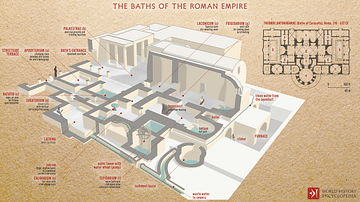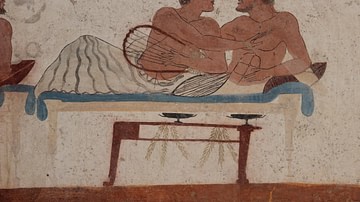Server Costs Fundraiser 2024
Help our mission to provide free history education to the world! Please donate and contribute to covering our server costs in 2024. With your support, millions of people learn about history entirely for free every month.
$3926 / $18000
Video
Roman Baths were designed for bathing and relaxing and were a common feature of cities throughout the Roman empire. Baths included a wide diversity of rooms with different temperatures, as well as swimming pools and places to read, relax, and socialise. Roman baths, with their large covered spaces, were important drivers in architectural innovation, notably in the use of domes.
Baths and the need to create large airy rooms with lofty ceilings brought the development of the architectural dome. The earliest surviving dome in Roman architecture is from the frigidarium of the Stabian Baths at Pompeii, which dates to the 2nd century BCE. The development of concrete in the form of stiff mortared rubble allowed unsupported walls to be built ever wider apart, as did hollow brick barrel vaults supported by buttress arches and the use of iron tie bars. These features would become widely used in other public buildings and especially in large constructions such as basilicae. Even in modern times Roman baths have continued to influence designers, for example, both the Chicago Railroad Station and the Pennsylvania Station in New York have perfectly copied the architecture of the great frigidarium of the Baths of Caracalla.
— SUPPORT US VIA OUR PATREON—
https://www.patreon.com/join/whencyclopedia
— BUY OUR MERCH —
https://www.worldhistory.store/
— CHAPTERS —
0:00 Introduction
0:56 The Roman Baths
4:42 Elements of Roman Bathing Complexes
6:10 Engineering and Architecture
8:45 Outro
— WANT TO KNOW MORE? —
Roman baths
https://www.worldhistory.org/Roman_Baths/
The Roman Baths in Bath- A Deep Dive into Britain’s Ancient History
https://www.worldhistory.org/article/1427/the-roman-baths-in-bath–a-deep-dive-into-britains/
Roman Architecture
https://www.worldhistory.org/Roman_Architecture/
Roman Mosaics
https://www.worldhistory.org/article/498/roman-mosaics/
Roman Daily Life
https://www.worldhistory.org/article/637/roman-daily-life/
— WATCH NEXT —
Ancient Rome Playlist
https://youtube.com/playlist?list=PLRIPanKDxKpt23JtCUEa7Cw787eohdqIP
Ten Fun Facts About Ancient Rome that you Need to Know!
https://www.youtube.com/watch?v=icGWztf5W0Q&list=PLRIPanKDxKpt23JtCUEa7Cw787eohdqIP&index
The Rise and Fall of the Roman Empire
https://www.youtube.com/watch?v=FtB0wxDKmbc&list=PLRIPanKDxKpt23JtCUEa7Cw787eohdqIP&index=13&t
Ancient Roman Society and Social Order
https://www.youtube.com/watch?v=rCC–cinutQ&list=PLRIPanKDxKpt23JtCUEa7Cw787eohdqIP&index=11&t
— ATTRIBUTIONS —
You can find all attribution and credits for images, animations, graphics and music here - https://worldhistory.typehut.com/the-famous-baths-of-the-roman-empire-images-and-attributions-17107
The music used in this recording is the intellectual copyright of Michael Levy, a prolific composer for the recreated lyres of antiquity, and used with the creator's permission. Michael Levy's music is available to stream at all the major digital music platforms. Find out more on:
https://www.ancientlyre.com
https://open.spotify.com/artist/7Dx2vFEg8DmOJ5YCRm4A5v?si=emacIH9CRieFNGXRUyJ9
https://www.youtube.com/channel/UCJ1X6F7lGMEadnNETSzTv8A
World History Encyclopedia
www.worldhistory.org
#history #ancientrome #romanhistory #romanbaths
Subscribe to this author
About the Author
![Kelly Macquire]()
Kelly is a graduate from Monash University who has completed her BA (Honours) in Ancient History and Archaeology, focussing on iconography and status in Pylos burials. She has a passion for mythology and the Aegean Bronze Age.
License & Copyright
Original video by Kelly Macquire. Embedded by Kelly Macquire, published on 15 June 2023. Please check the original source(s) for copyright information. Please note that content linked from this page may have different licensing terms.
The video and its description text are provided by Youtube. This website claims no authorship of this content; we are republishing it for educational purposes.
Cite This Work
APA Style
Macquire, K. (2023, June 15). The Famous Baths of the Roman Empire.
World History Encyclopedia. Retrieved from https://www.worldhistory.org/video/2967/the-famous-baths-of-the-roman-empire/
Chicago Style
Macquire, Kelly. "The Famous Baths of the Roman Empire."
World History Encyclopedia. Last modified June 15, 2023.
https://www.worldhistory.org/video/2967/the-famous-baths-of-the-roman-empire/.







